Author: Ignas, DeFi Research
Translated by: Tim, PANews
The issuance speed of new tokens has slowed down, but I believe everything will soon accelerate because:
- The market is slowly recovering
- Many projects can no longer delay their issuance.
These projects will test the waters and pave the way for others.
In this post, I want to highlight several protocols that frequently appear in my Twitter feed. However, it seems not everyone is familiar with what they do.
So, if you are one of those "trend followers" on Twitter who specialize in water posts and are waiting for token airdrops but do not understand what they are actually doing, then this post is for you.
Initia: The "Eden" of Multi-Chain Ecosystems
Initia completed its first sale on Cobie's Echo fundraising platform under the Echonomist Group.
Cobie's Echo fundraising platform has only completed three project financings to date, so Initia is worth watching. Additionally, the mainnet launch and airdrop plan could start at any time (though it seems to have been postponed to April).
If I had to choose one word to summarize Initia, it would be "interwoven."

Initia is an L1 network that builds a modular application chain ecosystem by integrating different L2s.
This sounds like Ethereum, but Initia aims to address the issues that ETH extremists have with Ethereum.
Unlike isolated Ethereum L2s, Initia deeply integrates L1 with L2 networks to create an interwoven ecosystem. These second-layer networks are referred to as "Minitias." This design concept is similar to the subnets of the Avalanche protocol (recently renamed to L1).
Unlike Ethereum, but similar to Avalanche, the OPinit stack supports three major virtual machine architectures: EVM, MoveVM, and WasmVM. This means developers can choose the programming language they are most familiar with for development.
This may make ETH enthusiasts drool. Initia's on-chain liquidity mechanism allows for the separate staking of INIT tokens or the use of approved INIT-X liquidity pool tokens (paired with INIT tokens) to earn rewards through a Delegated Proof of Stake (DPoS) mechanism.
The built-in liquidity is good Ponzi economics, as this mechanism forces 50% or more of INIT to be used as trading pairs. These LP tokens must be authorized through a whitelist.
Similar to Berachain, Initia also has a native decentralized exchange: InitiaDEX, built on Layer 1 using the Move programming language. It serves as the liquidity hub of the Omnitia ecosystem, and from my understanding, most liquidity will flow through InitiaDEX (as well as the enforced INIA liquidity pool) even between different L2s.
Initia has more features, such as a native cross-chain bridge (named Minitswap) and a Vested Interest Program (Rollups can earn rewards by creating DAPPs and expanding new use cases for INIT tokens). But for me, the four core functions mentioned earlier remain the project's most prominent highlights.
Initia integrates the demands of Ethereum's native users into one product, creating an interwoven ecosystem.
Token and Financing Situation
Details of the token economics have not yet been fully disclosed. Initia has only shared four relevant details:
- 50% of the supply is allocated to VIPs and reserved liquidity pools
- No unlocked staking rewards for insiders
- Community rounds enjoy about a 30% discount.
- 15% belongs to investors
We can expect the Initia project to adopt a vesting airdrop method, as its co-founder Zon previously stated, "vesting is a gift. It prevents you from selling too early and forces you to maintain faith."
In September 2024, Zon also revealed to The Block that Initia completed a $14 million Series A financing at a $350 million FDV, with investors including Theory Ventures, Delphi Ventures, Hack VC, and others.
The testnet has an incentive mechanism, so be sure to interact with the official testnet website, claim test tokens, and participate in ecosystem building. All details can be found on its testnet-related pages.
As usual, I do not have high expectations for testnet activities.
Overall, the Initia ecosystem is well-constructed, but a key question remains: Will builders and users choose to deeply engage?
Fogo: The Fastest Layer 1 Blockchain
Fogo is another project that conducted token issuance on Cobie's Echo platform, raising $8 million at a $100 million valuation.
Fogo uses the highly optimized Solana validator client Firedancer, developed by Jump Crypto, as its only execution client on the network.
Firedancer has not even been enabled on the Solana network yet. Solana will soon benefit from the Firedancer client, but not all validators will switch to using this client immediately. This means the speed of the Solana network will be limited by the slowest node.
Fogo co-founder Doug Colkitt once said, "It's like having a Ferrari but only being able to drive it on congested roads in New York City."
They revealed that Fogo's theoretical speed can reach up to 1 million transactions per second (with a block time of 20 milliseconds) under ideal conditions, but the developer network that Fogo has launched has only achieved about 54,000 TPS. In comparison, Solana's current theoretical limit is 65,000 TPS, while its actual processing speed is 4,300 TPS.
The MegaETH testnet achieved a high throughput of 20,000 TPS with a block time of 10 milliseconds.
In contrast, traditional financial systems can handle about 100,000 operations per second, with latency controlled at sub-second levels.
The Fogo team believes that decentralized networks must reach the level of traditional institutions to meet the demands of high-frequency trading and instant payments.
It runs the Solana Virtual Machine (SVM), which means developers can easily migrate Solana applications, tools, and infrastructure to the Fogo chain without any modifications. A wave of forks is expected, with "shiny" new tokens (such as Jupiter, Kamino, Pumpfun, etc.) appearing on the Fogo chain.
Clearly, not all participants in the Solana ecosystem are pleased about this.

Notably, Fogo's contributors include members from Douro Labs, the development force behind the oracle network Pyth, which is closely associated with Jump Crypto.
Other notable features of Fogo:
- Multi-local consensus ("solar revolution"): Fogo divides validators into geographically "regions" that can operate semi-independently. Network control will rotate regularly to the next "region," preventing any single validator from gaining a dominant advantage. This means consensus can be reached faster during normal operations, as information does not always have to travel around the entire "earth."
- At network launch, it will initially be equipped with a group of validators (20-50 people).
- GAS fee abstraction: Supports using any token to pay network fees.
Token and Financing Situation
Fogo raised about $5.5 million in a seed round led by Distributed Global, with CMS Holdings participating. Previously, the company had secured $8 million in funding from the Echo platform.
The developer network is set to launch by the end of 2024, with the testnet coming soon and the mainnet expected to start in mid-2025. Currently, there is little information about tokens or airdrops.
Succinct: Building Truly World Software
"Cryptocurrency has failed to fulfill its mission."
"We were promised a transparent, verifiable, and trustless global coordination system. However, what we got was: cross-chain bridges being hacked, multi-signature L2 networks without fraud proofs, and a committee of 21 validators controlling billions of dollars."
(Note: This refers to EOS developed by Blockone)
This is the main problem that Succinct is addressing.
"ZK zero-knowledge proofs are one of the most critical technologies for blockchain scalability, interoperability, and privacy protection, but their complexity currently makes it difficult for most developers to master."
It is indeed hard to feel excited about the progress of zero-knowledge proofs right now, but Succinct has successfully caught my attention with its brilliant marketing campaign: they designed the testnet and official dashboard with a MacOS-style interface.
You can play games and earn points.

In summary, the problems we face now are:
Each project needs to build its own proof system (for example, zkSync and Scroll achieve scalability through zero-knowledge proof technology, but the infrastructure is fragmented).
Many people rely on centralized service providers to generate proofs.
This approach is costly and hinders innovation.
Therefore, Succinct ZKPs are a technology that can verify authenticity through cryptography without revealing data. However, due to the fragmentation of infrastructure and high implementation costs, it faces significant challenges in practical applications.
Succinct provides a shared market for proof generation, allowing each project to avoid "reinventing the wheel." Developers can focus on building applications (such as Rollups, cross-chain bridges, or oracles) while outsourcing the proof generation work to network nodes.
Notable partners: Polygon, Celestia, Avail, Gnosis
But the application scenarios are actually more diverse, such as private voting systems or anonymous transaction scenarios. Or users can prove that they indeed have enough funds in their wallets without actually displaying the amount.

This is a technical project, but it may become a key link to connect and protect most vulnerable crypto projects.
Their testnet—Phase One: Trust Crisis, was launched two months ago. Users can earn star rewards by generating zero-knowledge proofs, but they need to pay 10 USDC to cover the proof generation costs. Notably, invitation codes can only be obtained through active participation in community interactions on Twitter, Discord, etc.
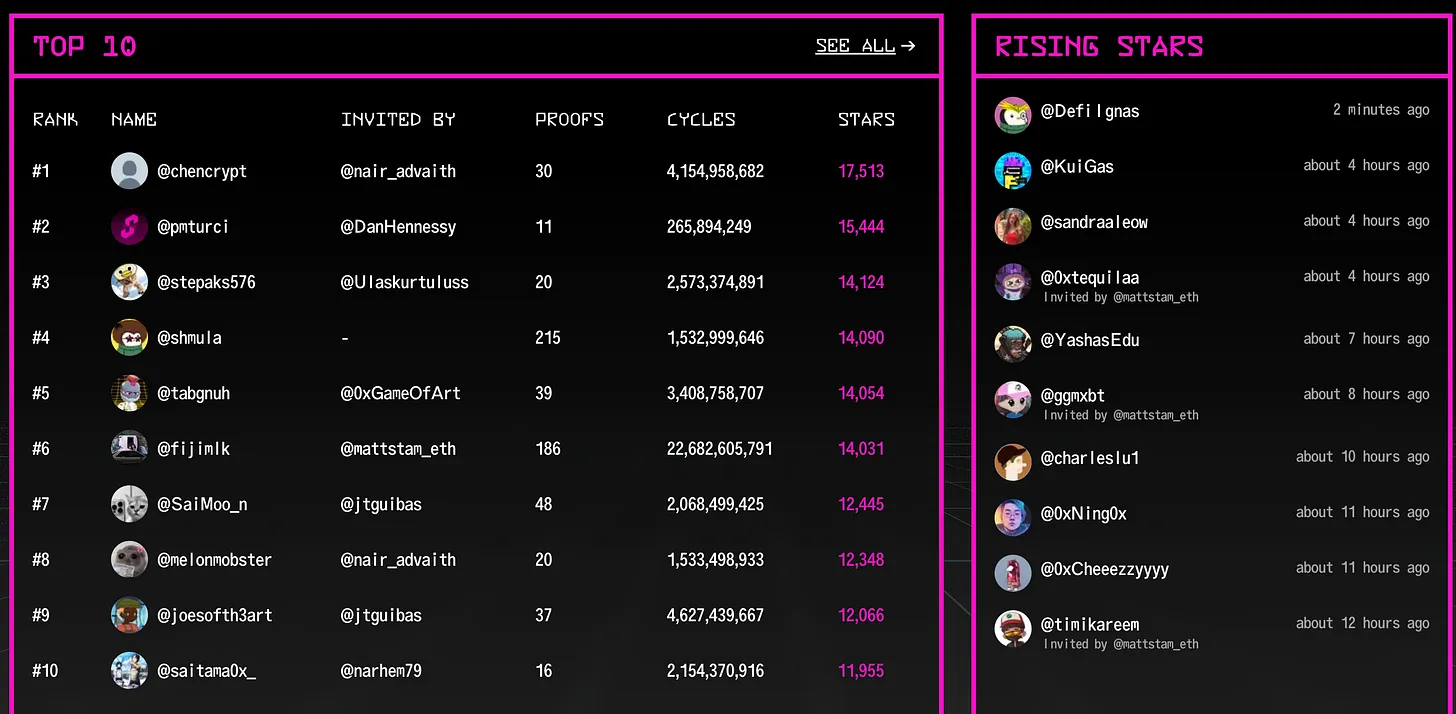
I suspect there will be certain standards for the airdrop, but the detailed information about the tokens has not been disclosed yet.
Token and Financing Situation
Succinct has completed a $55 million financing round, led by Paradigm, with participation from several institutions including Robot Ventures, Bankless Ventures, and Geometry.
When the mainnet officially launches, a TGE is expected to occur soon after.
Resolv: A Truly Effective Delta-Neutral Stablecoin
Many people now believe that the next round of altcoin surges will be driven by the accelerated entry of institutional funds, especially stablecoins.
The current challenge is that the main beneficiaries of stablecoins seem to be institutions and stablecoin issuers, while retail investors may only get the leftovers.
The Third Round of Retail Squeeze?
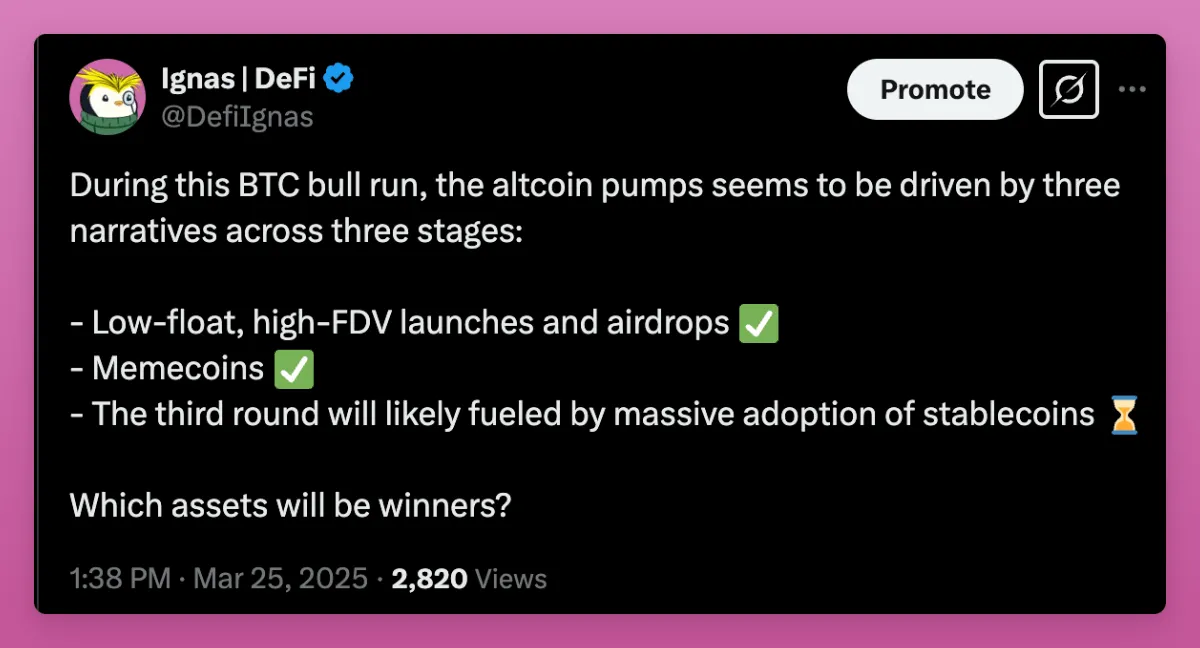
I wrote some thoughts on protocols that may benefit from stablecoin adoption, but I want to add another protocol here: Resolv.
If you understand how Ethena operates, then you already have the foundational knowledge to learn about Resolv.
The core idea of Ethena and Resolv is completely aligned, which is to create stablecoins through a combination of crypto asset collateral and perpetual contract short hedging. However, Resolv's uniqueness lies in its architectural design and implementation path:
1. Dual Token Model vs. Single Token Model
Ethena uses a single token model (USDe), where all risks and rewards are borne by stablecoin holders, managed by the protocol's reserves in the background.
Resolv employs a dual token model (USR + RLP), achieving risk separation by clearly isolating risks into independent tokens.
USR is similar to USDe, maintaining its peg through delta-neutral strategies and hedging ETH price risks by shorting futures. Users can earn rewards by staking USR, while converting it to stUSR, which functions similarly to a savings account.
RLP serves as an insurance mechanism for USR, maintaining the stability of USR by absorbing losses (for example, when the funding rate is negative). RLP holders take on higher risks for potentially greater rewards. Its value fluctuates with the protocol's performance, essentially acting as a dynamic buffering mechanism: it increases in value when the protocol is profitable and shrinks when it incurs losses.
This mechanism allows risk-seeking users to achieve higher returns while protecting stablecoin users from market risks. As of the writing of this article, USR (Stable Yield Reserve) offers an annualized interest rate of 4.3%, while RLP (Risk Liquidity Pool) provides an annualized yield of 6.7%.
Although these rates are not particularly high, Resolv's strategy of obtaining airdrops through points mining has led to a total locked value (TVL) of $637 million, which is quite impressive.
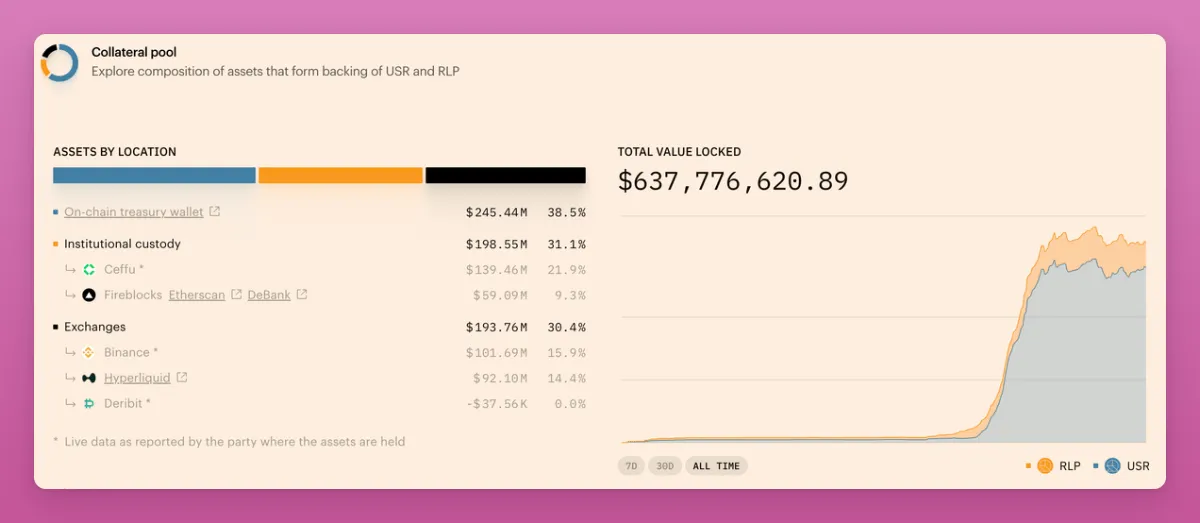
2. Differences in Collateral Asset Sources
The core idea of Resolv is fully supported by cryptocurrencies. All collateral is ETH (recently announced to include BTC support), and it does not involve any real-world assets (RWA).
Initially, Ethena also only supported cryptocurrencies, but later introduced a secondary stablecoin, USDtb, which is 90% backed by BlackRock's tokenized money market fund BUIDL.
USDtb is somewhat of an insurance token, similar to the USR token in the Resolv project, designed to maintain the value stability of USDe by providing traditional asset yields when cryptocurrency yields decline during bear markets.
Thus, it can be said that Resolv is essentially more "crypto-native" and adheres to decentralization principles, while Ethena's strategy of introducing centralized assets may provide additional stability guarantees.
Token and Financing Situation
Resolv has not officially disclosed financing details, but its investors include Delphi Labs, Daedalus, and No Limit Holdings. Additionally, the project is planning to raise funds through the Legion platform, with a community round set to launch soon.
Starting in September 2024, Resolv will officially launch a points reward program. Users can still earn points by depositing stablecoins.
After depositing, you can maximize point acquisition through Pendle pools or other strategies.
The $RESOLV token is expected to be issued in early 2025.
Snapchain: Possibly the Largest Consumer-Level Layer 1 Public Chain
My biggest concern about emerging blockchains like Fogo and Initia is whether they can truly achieve market adoption. What killer applications will emerge on these chains? As Kyle said, "General-purpose blockchains will fade away. Each chain must have a clear application scenario, and these scenarios will be defined by the content built on-chain."
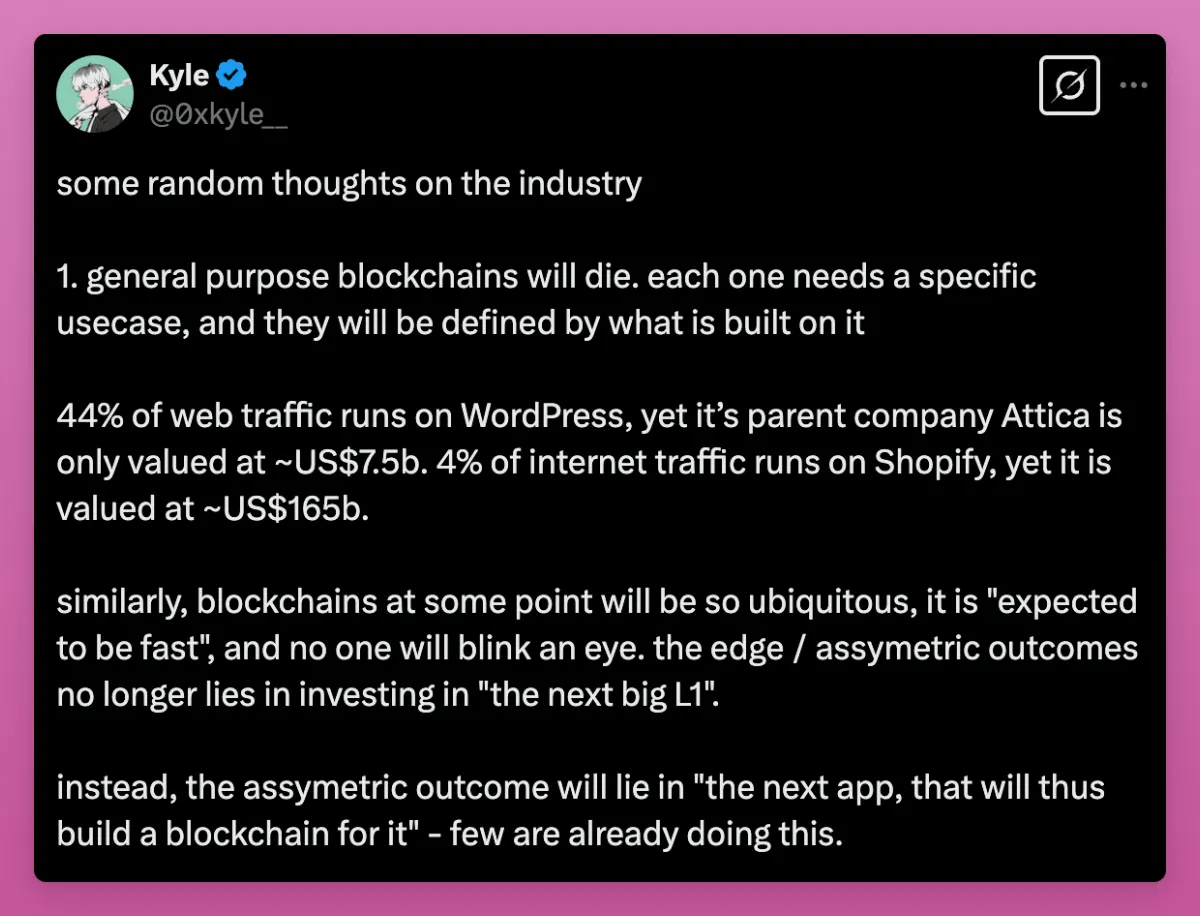
This is where Snapchain, a Layer 1 blockchain designed specifically for the Farcaster social network, shines.
The birth of Snapchain stems from the common pain points of decentralized social networks when scaling, particularly data synchronization difficulties and real-time update delays. While the Lens protocol chose to adopt zkSync technology, the Farcaster team is developing a solution tailored to its ecosystem.
"For example, Twitter has 200 million daily active users, processing 10,000 transactions per second (TPS), with daily state data growth potentially between 1TB and 10TB."
The current system of Farcaster runs well on a small scale, but it crashes as the number of users and nodes increases. Snapchain will address this issue in a decentralized manner.
At the launch of the mainnet, it is expected to achieve over 9,000 TPS, capable of supporting 2 million daily active users (currently around 50,000 daily active users).
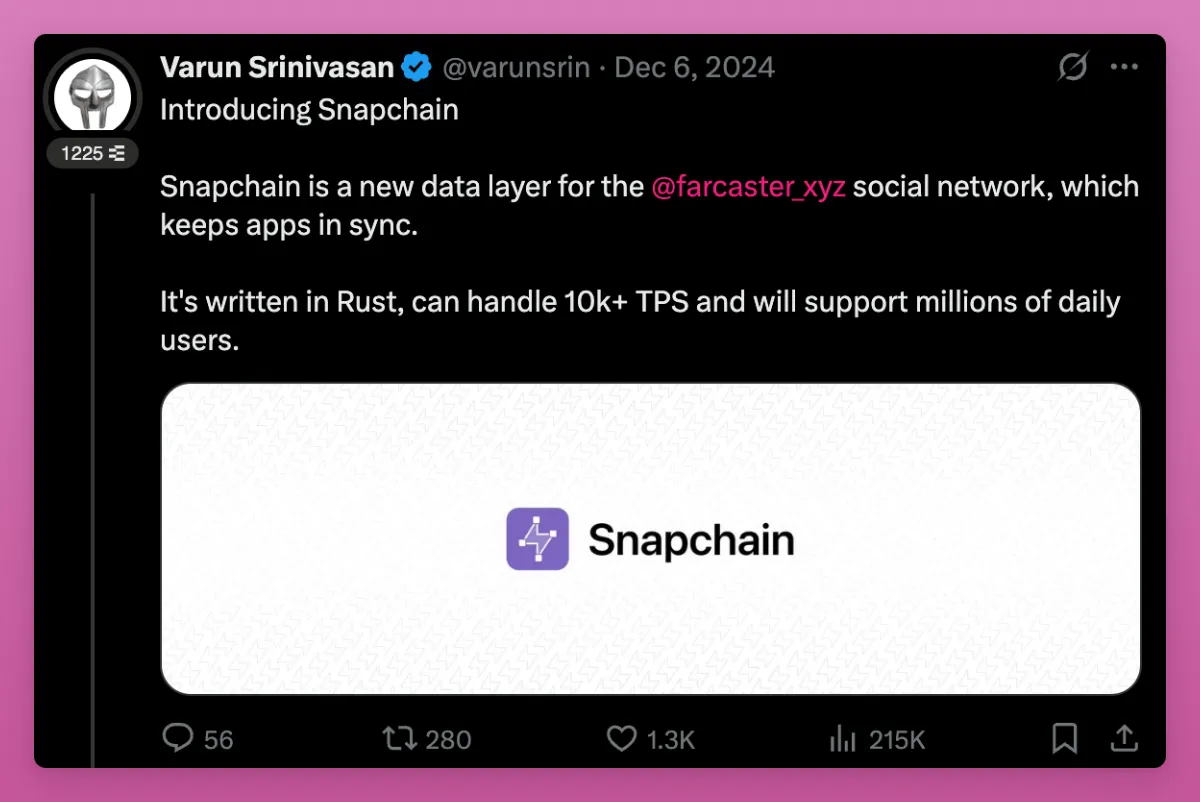
I won't get too caught up in the technical details, but there are two exciting highlights coming up:
First is the ability to delete data (i.e., data pruning), which is both amusing and practical.
On the blockchain, most data needs to be permanently stored, but what if you just sent a meme and immediately regretted it? It must disappear! Forever!
Therefore, on Snapchain, old data (such as posts, likes, follows) can be deleted once it is no longer needed.
Users can pay $2 or $3 per year to achieve a processing speed of 500 transactions per hour and a storage limit of about 10,000 transactions, which is crucial.
Thus, if old transactions are deleted, it frees up storage space for new transactions (or you can choose to pay more to retain old transactions).
The second cool aspect is sharding technology. It's worth noting that Ethereum considered using sharding technology for scalability before transitioning to Layer 2 solutions.
Imagine recording all social media interactions (likes, posts, etc.) on the blockchain. Millions of data points daily. If every node must store and process all content, it leads to delays. Each full node needs to handle every transaction, even if those transactions are unrelated to them. This model works for currency transfers and smart contracts, but it clearly lacks scalability when faced with real-time social applications that require high scalability.
Snapchain solves this problem by allowing each user to be completely independent (when registering on Farcaster, you receive an ID number, and the smaller the number, the more prestigious it becomes). Your posts do not affect my account.
Snapchain distributes users across multiple shards (by the way, this design inspiration comes from Near's model). Each shard only processes transactions belonging to its users. This means that as the number of users grows, the number of shards increases, thereby enhancing the system's throughput.
To ensure all shards remain synchronized, there is a final layer: a main chain that packages and publishes global blocks from each shard.
Ethereum cannot easily achieve this. Its transactions rely on shared state—smart contracts, tokens, and balances. This makes account-level sharding difficult to implement.
Snapchain is effective because social behaviors are simple enough. These behaviors only affect the sender themselves.
There is more content related to Snapchain, and details can be found here. However, I am optimistic about Farcaster and Snapchain because they are adopting a "build applications first, then launch the chain" strategy, which means first creating actual application scenarios and then adding blockchain infrastructure.
Hyperliquid has seen significant success with this strategy, and although Farcaster only has 50,000 daily active users and 900,000 total users, it remains one of the top consumer applications.
Launch Date and Token
In short: the genesis block has been successfully activated, and the mainnet is scheduled to officially launch on April 15, 2025. This is just around the corner!
I believe that once Snapchain officially launches and Farcaster is ready to scale, this social ecosystem will integrate into the Coinbase wallet.
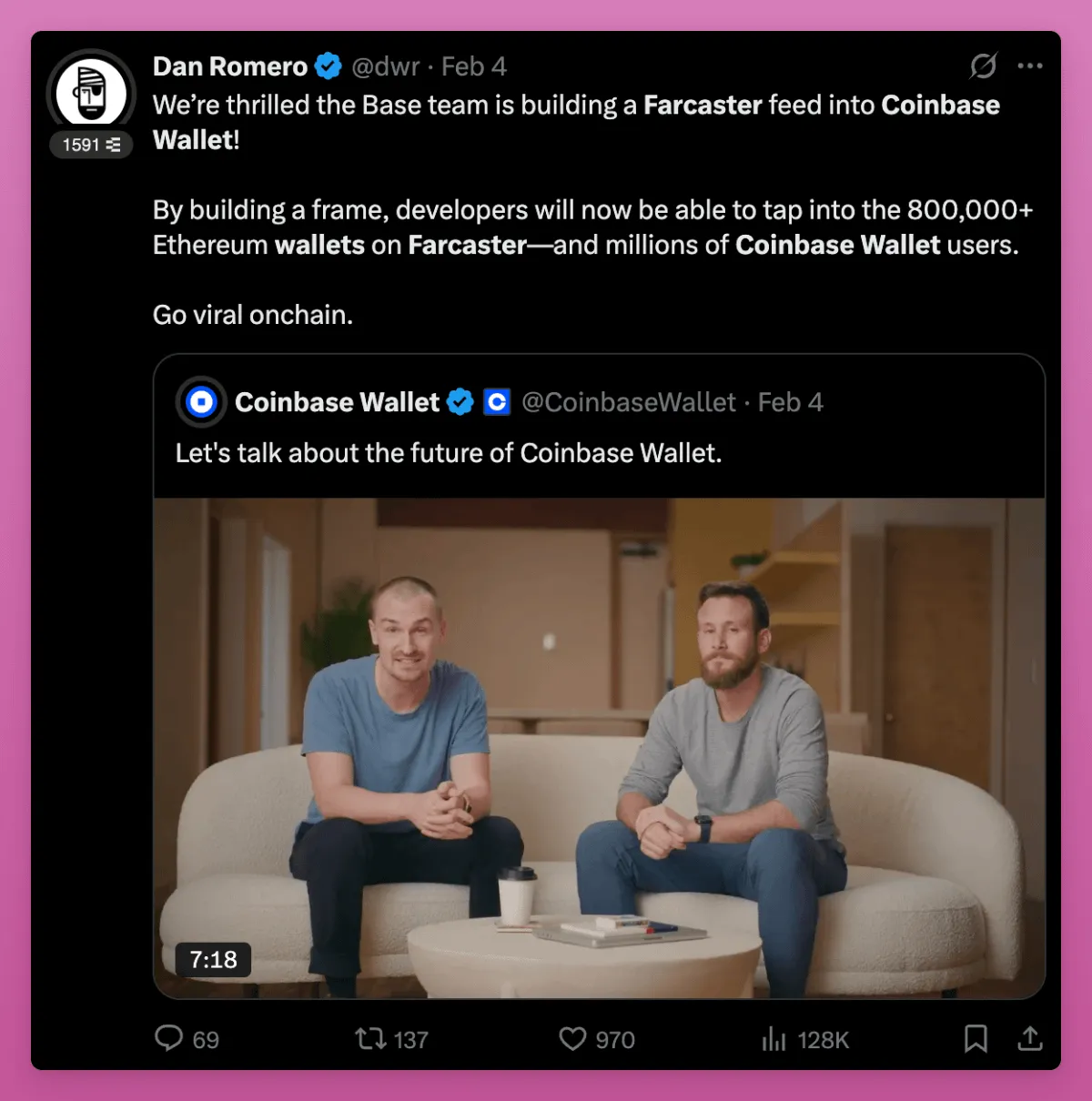
The integration of social media information streams into the Coinbase wallet is a significant development.
However, I am not sure when the tokens will specifically launch; the team has remained tight-lipped about it, but recent rumors and financing news likely indicate that it is coming soon.
Financing
Snapchain itself is a technical component rather than an independent fundraising entity. The development of Snapchain is funded by Merkle Manufactory, which is building the Farcaster protocol.
Most notably, in May 2024, Merkle Manufactory announced the completion of a $150 million financing round, led by Paradigm, with participation from other major investors including a16z crypto, Haun Ventures, USV, Variant, and Standard Crypto.
免责声明:本文章仅代表作者个人观点,不代表本平台的立场和观点。本文章仅供信息分享,不构成对任何人的任何投资建议。用户与作者之间的任何争议,与本平台无关。如网页中刊载的文章或图片涉及侵权,请提供相关的权利证明和身份证明发送邮件到support@aicoin.com,本平台相关工作人员将会进行核查。




